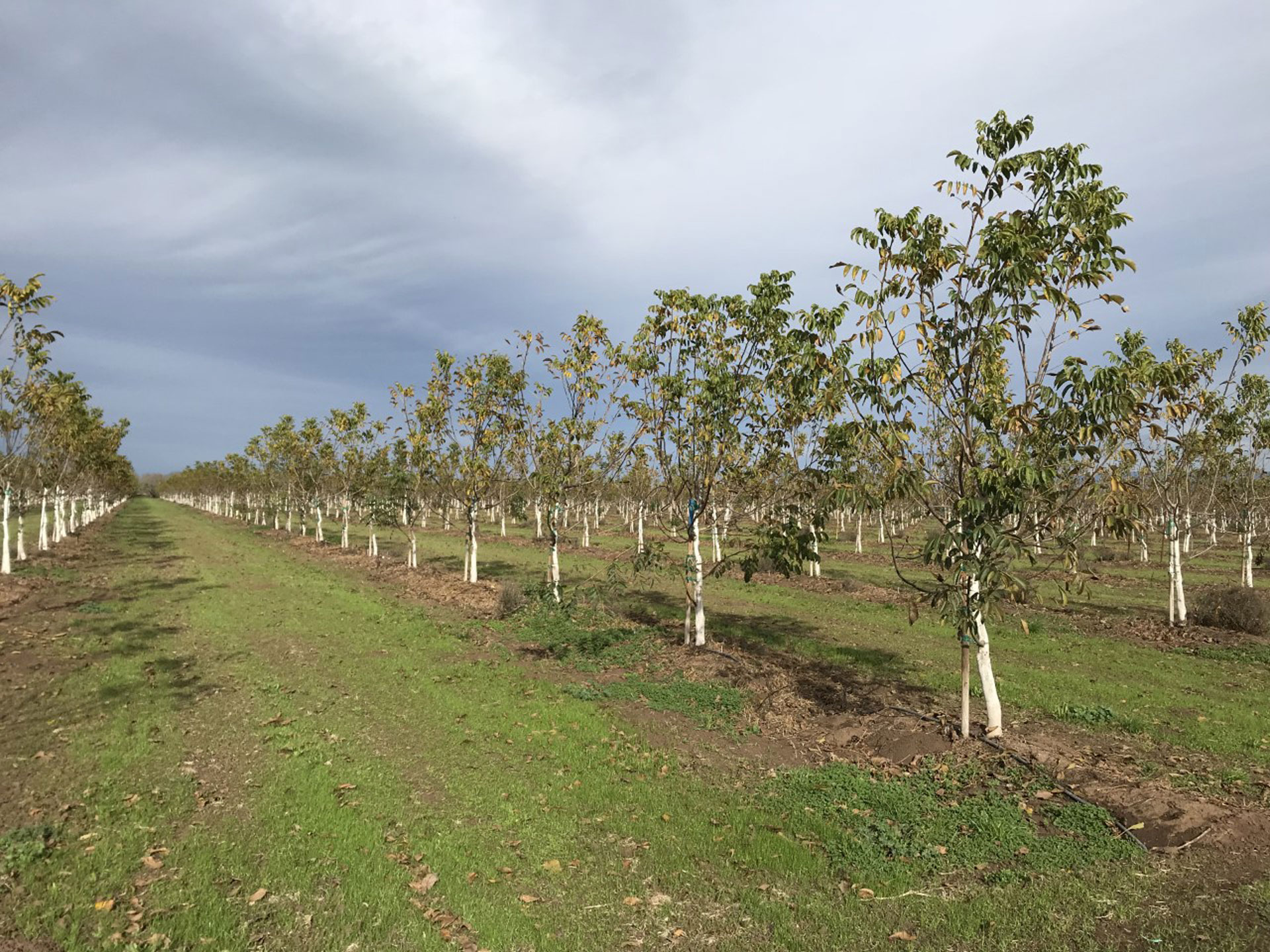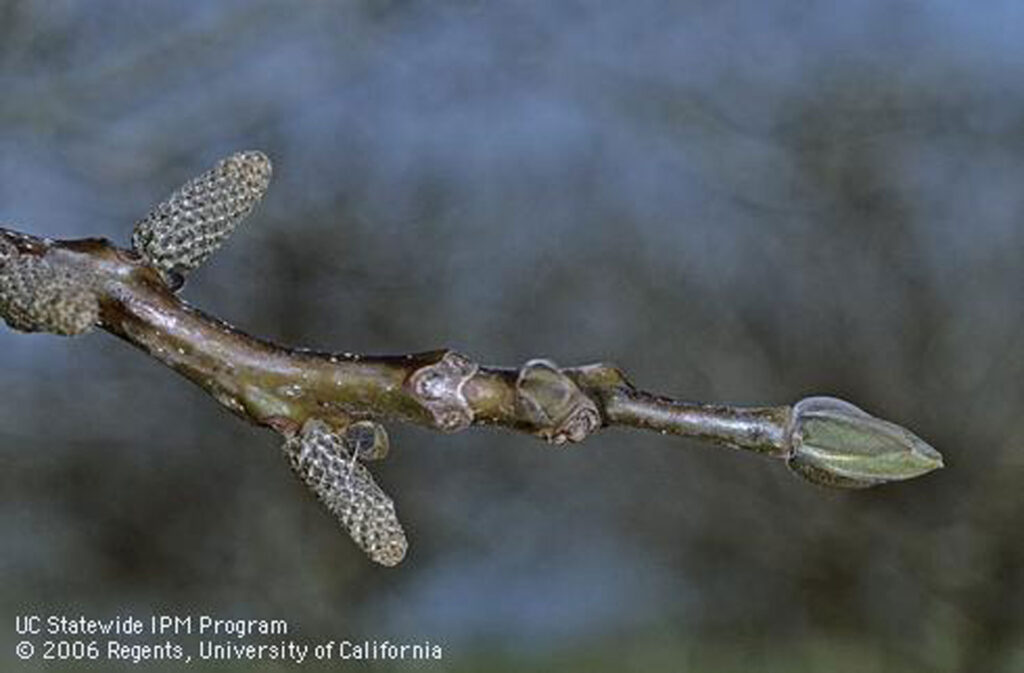
December and January provide ideal opportunities for walnut growers to get a head start on weed and disease control programs. In terms of weed control, that may mean laying down some long-residual preemergence herbicides to keep orchard floors clean going into spring. In terms of disease control, the early winter is an ideal time to measure walnut blight inoculum levels and prepare your season-long control strategy.
Luke Milliron, UCCE farm advisor for Butte, Glenn and Tehama counties, said most growers have a good sense of the walnut blight inoculum in their orchards from monitoring nut drop the previous May, June and July. In cases where they don’t, he advises to scout in winter months and sample for inoculum levels in walnut spurs with terminal buds.
According to the UCCE walnut blight sample guidelines, buds can be sampled up to the time they start to open, or anytime from December into early April for late-leafing varieties. But earlier sampling provides more time for designing disease control strategies.
The sampling guidelines include a recommendation that growers cut 100 or so three-inch-length dormant spurs with fat terminal buds from several trees in an orchard. “Walk the entire area, collecting a random sample,” the guidelines state. “One or two buds per tree should spread the sample adequately… One sample could easily represent 50 acres if experience suggests reasonable uniformity.”
Growers or PCAs should place samples in paper bags, which will allow samples to breathe and eliminate condensation, and store them in a cool, dry place before mailing to a lab. UCCE advisors can help interpret lab findings and discuss the relative disease risks.
Getting a bead on walnut blight inoculum levels and utilizing an aggressive spray program, if necessary, are keys to staying ahead of a disease that ranks as the number one disease threat to walnuts, according to Milliron.
The disease is caused by the bacterium, Xanthomonas arboricola pv. juglandis (Xaj), which overwinters inside dormant bud scales and causes infection in spring when it is rain splashed onto developing shoots and flowers.
Low Blight Pressure
Fortunately, blight pressure has been low the last two years, Milliron said, and inoculum levels should be low this winter. “A lot of people will be going into this next spring hopefully with very little blight pressure, because we’ve had those two back-to-back dry years,” he said.
In cases where blight pressure is high, Milliron advises growers to act early. “If you know you have high blight pressure, you are going to start earlier in terms of sprays, really quite early, just the very start of prayer stage or catkin emergence,” Milliron said. “And you are going to be back with a second spray a week after that. “It is a very aggressive program. You are going to treat it differently [than if you have low disease pressure].”
He added that regardless of pressure levels, growers will want to get a spray on ahead of rain events. “That doesn’t change,” he said. “The advantage of knowing inoculum levels ahead of time is really more about how early you start and how aggressive you are with those first two sprays.”
If treating for walnut blight, growers should consider utilizing Kasumin in combination with copper or mancozeb, according to UCCE guidelines. Kasumin, which was registered for use in walnuts in March of 2018, offers excellent and consistent efficacy when applied with either copper or mancozeb, according to UCCE research. The product also has a unique mode of action, providing an excellent rotational material for resistance management.
Milliron advised growers to follow label directions when spraying for walnut blight and to rotate chemistries to avoid the build-up of resistance.
“If the effectiveness of the copper-mancozeb combination was lost due to resistance, it would be an incredibly tough hit to the industry, particularly in the Northern Sacramento Valley where rainfall levels are the greatest,” Milliron wrote in a Sacramento Valley Orchard Source article in 2018.
Winter Weed Control
Like walnut blight programs, winter weed control programs require a good understanding of the pressure in an orchard. According to a Sacramento Valley Orchard Source article from Milliron and UCCE Weed Specialist at UC Davis Brad Hanson, that understanding often comes from past observances and a fall weed survey. Documenting weed discovery and escapes is also advised to help growers understand what worked and what didn’t in last year’s program and to help in devising a change in strategy if need be.
“I think it is really important to be smart about understanding the weed problem you are trying to resolve,” Hanson said. “That includes properly identifying the weed and having some idea of its biology, such as when does it come up versus when are my interventions.”
In developing orchards, UC Davis weed management guidelines say it is important to maintain a weed-free strip at least 30 inches from the trunk of trees to prevent weeds from competing with trees for water and nutrients. In established orchards, weed control is less about removing competition for water and nutrients, although that remains a consideration, and more about improving water distribution, removing impediments to harvest operations and removing habitat for vertebrate pests, insects, mites, nematodes and diseases.
December and January offer ideal opportunities for growers to come in with long-residual preemergence herbicides that will be worked into soil with winter rains. “If rains do not come after application, you may need to water in your preemergent herbicide if your irrigation system and water availability allow it,” Milliron said.
The treatment regime will depend on a variety of factors, according to the UC Davis Integrated Weed Management guidelines, including soil type. Different soil textures and organic matter tend to influence the types of weeds present and can factor into control tactics. On light-textured soils, annual species such as puncturevine, crabgrass and horseweed, and perennial species such as johnsongrass, nutsedge and bermudagrass, are more common. Perennial weeds, such as curly dock and field bindweed, are more common on heavier soils.
When devising control strategies, it is important to remember that clay or clay loam soils often require higher rates of preemergence herbicides to achieve the same level of weed control than in light, sandy soils. Good herbicide-to-soil contact also is important for a successful herbicide application, so it is important to keep orchard floors and berms clean by removing leaves and other debris before treatment.

Hanson provided a list of several preemergence and postemergence herbicides that could have a fit in different orchards, depending on weeds targeted, soil textures and other factors. The list includes indaziflam (Alion), penoxsulam (PindarGT) and flumioxazin (Chateau and others). Products that typically work well in tank mixes include pendimethalin (Prowl H20 and others), rimsulfuron (Matrix and others), flazasulfuron (Mission) and oxyfluorfen (Goal, GoalTender and others).
“I usually think of those first three as the heavy hitters in this market,” Hanson said. “But good programs can be built for specific sites out of many of them in various combinations.”















